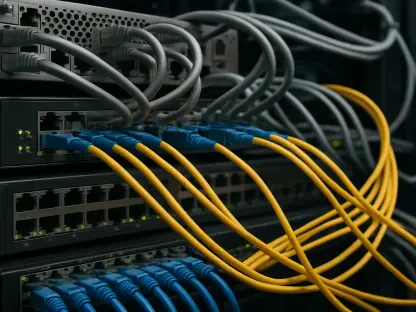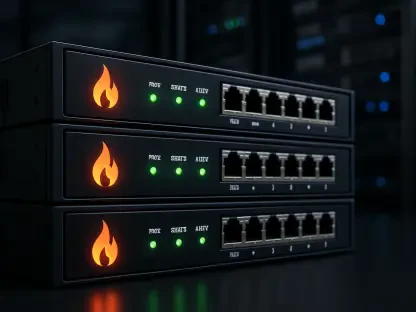The latest update in IP Fabric’s automated network assurance platform, version 7.0, brings a host of new features aimed at enhancing network visibility, improving automation capabilities, and addressing the complexities of hybrid networking environments. This update is designed to help organizations manage the intricacies of modern networking, which increasingly spans cloud and edge deployments. With a comprehensive suite of features, IP Fabric 7.0 aims to streamline network operations, enhance security and compliance, and provide granular insights into various networking environments.
Enhanced AWS Networking Visibility
Support for Direct Connect Transit VIF and Transit Gateway
One of the primary enhancements in IP Fabric 7.0 is its increased visibility into AWS networking environments. The platform now supports Direct Connect Transit VIF and Transit Gateway, allowing network teams to track traffic patterns and routing behaviors with greater detail. This enhanced capability is crucial for organizations relying on AWS to ensure optimal network performance and troubleshooting. By enabling network teams to closely monitor these elements, the platform facilitates proactive network management and swift response to potential issues.
This level of detailed monitoring is essential for businesses utilizing AWS, as it ensures consistent and reliable network operations across cloud environments. With Direct Connect Transit VIF and Transit Gateway support, organizations gain deeper transparency and can quickly diagnose and address any disruptions or inefficiencies. This means that routing policies are not only correctly implemented but also continuously optimized to align with the organization’s operational needs. Enhanced AWS networking visibility is a key advancement for IP Fabric in maintaining robust cloud infrastructure and delivering higher standards of network reliability.
Detailed Traffic and Routing Insights
With the new update, network teams can gain deeper insights into traffic patterns and routing behaviors within AWS environments. This level of detail is essential for troubleshooting and optimizing network performance, ensuring that routing policies are correctly implemented and that any issues can be quickly identified and resolved. Enhanced visibility into traffic and routing aids in identifying bottlenecks or anomalies that could lead to performance degradation. This results in improved service delivery and efficient utilization of network resources.
In addition to improving troubleshooting capabilities, these detailed insights facilitate better strategic planning and forecasting. By understanding traffic trends and how routing decisions impact network performance, organizations can make data-driven adjustments to their network architecture and policies. This proactive approach helps in mitigating the risks associated with network downtime or suboptimal performance, thus supporting consistent business operations. The detailed traffic and routing insights provided by IP Fabric 7.0 represent a significant step forward in enabling businesses to manage their AWS environments with greater precision and confidence.
Advanced BGP Analytics
Real-Time Route Advertisement Monitoring
Another significant update in IP Fabric 7.0 is advanced Border Gateway Protocol (BGP) analytics. This feature enables engineers to monitor route advertisements between devices in real time, simplifying the troubleshooting process in complex environments where routing issues can be particularly challenging to diagnose. By offering real-time monitoring of route advertisements, IP Fabric provides invaluable tools for maintaining network integrity and performance within intricate infrastructures.
The addition of real-time BGP analytics means that network engineers can quickly detect and respond to any discrepancies in route advertisements. This immediate feedback loop is essential for maintaining optimal routing practices and minimizing latencies or route failures. Real-time BGP analytics empowers network teams to anticipate potential disruptions and manage routing dynamically, ensuring that critical path routing policies are adhered to strictly and that any deviations are promptly corrected. This capability is transformative for businesses operating in environments where timely and accurate routing is paramount to operational success.
Simplified Troubleshooting in Complex Environments
By providing detailed insights into routing behaviors, IP Fabric 7.0 helps ensure that routing policies are correctly implemented across the network. This capability is particularly valuable in complex environments where routing issues can be difficult to diagnose and resolve without comprehensive visibility. The platform’s ability to simplify troubleshooting by offering granular analytics on routing behaviors significantly reduces the time and effort required to pinpoint and address issues.
Moreover, the complexity of modern network environments necessitates tools that can demystify intricate routing scenarios. IP Fabric’s advanced BGP analytics equip network engineers with the visibility needed to comprehend and rectify complex routing interdependencies efficiently. By streamlining the troubleshooting process through improved analytics, the platform supports more reliable and resilient network operations. Consequently, organizations can maintain higher levels of service continuity and network robustness, ensuring that their IT infrastructure aligns with operational and strategic objectives.
Expanded SD-WAN Support
Enhanced Visibility into SD-WAN Environments
The platform also expands support for Software-Defined Wide Area Network (SD-WAN) environments, including Silverpeak and Viptela. This enhancement allows for better visibility into performance metrics and connectivity status across distributed networks, helping organizations manage their SD-WAN deployments more effectively. Enhanced visibility into SD-WAN environments provides critical operational insights, enabling businesses to optimize their WAN strategies and ensure peak performance.
With visibility into performance metrics such as latency, jitter, and throughput, IP Fabric users can more accurately assess the health and efficiency of their SD-WAN deployments. This data-driven approach allows IT teams to preempt potential issues and tailor configurations to meet evolving business needs. Enhanced visibility into connectivity status ensures that all components of the SD-WAN infrastructure are functioning optimally and that any anomalies can be swiftly addressed. This comprehensive support for SD-WAN environments underscores IP Fabric’s commitment to improving network operations through advanced visibility and management tools.
Automated Intent Verification Checks
Additionally, the update introduces over 160 new automated intent verification checks. These checks help organizations verify their compliance and security postures more effectively, ensuring that their networks are configured correctly and securely. By automating these checks, IP Fabric reduces the manual effort required to maintain network compliance and security, allowing IT teams to focus on higher-priority tasks.
Automated intent verification checks streamline the process of validating network configurations against predefined security and compliance policies. This continuous verification mechanism ensures that networks remain aligned with regulatory requirements and internal security standards. The ability to automate these checks means that potential vulnerabilities or misconfigurations can be identified and rectified promptly, thus enhancing the overall security posture of the organization. Through these checks, IP Fabric 7.0 provides a robust framework for sustaining network integrity and security in increasingly complex and dynamic environments.
Network Digital Twin Capability
Creating Shareable Snapshots
One of the standout features in IP Fabric 7.0 is the network digital twin capability. This feature allows users to create shareable snapshots of their network configurations, providing a virtual replica of the network for testing and validation purposes. This capability is particularly beneficial for organizations looking to test changes or updates in a controlled environment before deploying them in production. The ability to create shareable snapshots means that network testing can occur without risking the operational environment.
By offering a digital twin of the network, IP Fabric provides a powerful tool for simulating and validating network changes. This approach reduces the likelihood of introducing unforeseen problems during actual deployment, as configurations can be thoroughly tested in a risk-free environment. Shareable snapshots also facilitate collaboration among network engineers and stakeholders, enabling more coordinated and informed decision-making processes. The digital twin capability is instrumental in enhancing network reliability and stability by ensuring that all changes are meticulously tested and validated before implementation.
Testing and Validation in a Controlled Environment
The network digital twin capability enables organizations to test changes or updates in a controlled environment, reducing the risk of unintended issues arising from modifications. This feature helps ensure that network changes are thoroughly vetted before being implemented in production, enhancing overall network stability and reliability. Thorough testing and validation in a controlled setting mean that potential disruptions or faults can be identified and addressed before affecting the live network, thus safeguarding business operations.
Organizations benefit from the ability to simulate various scenarios and assess the impact of network changes without compromising live environments. This proactive approach to network management facilitates continuous improvement and innovation within IT infrastructure, ensuring that network performance and dependability are consistently maintained. The controlled testing environment provided by the network digital twin capability underscores IP Fabric’s commitment to delivering advanced tools that enhance operational confidence and reduce network-related risks.
Multi-View Dashboards
Role-Specific Network Insights
The article also highlights the introduction of multi-view dashboards in IP Fabric 7.0. These dashboards provide role-specific network insights, enabling different types of users to access data relevant to their specific needs. For instance, a cloud engineer working on segmentation for PCI-DSS compliance can view data pertinent to that use case, while a DevOps professional focusing on automation workflows can access different information. Role-specific insights ensure that professionals at various levels can efficiently utilize the network data most relevant to their roles.
The role-specific dashboards aim to simplify the user experience by eliminating the need for extensive coding or scripting to access required information. This customization ensures that users spend more time analyzing critical data rather than navigating through unnecessary details. By tailoring insights to specific roles, the platform enhances productivity and decision-making capabilities within organizations. Multi-view dashboards thereby support a more intuitive and efficient interaction with network data, enabling users to achieve their objectives effectively and expeditiously.
Enhanced User Experience
This feature aims to enhance user experience by providing tailored visibility into network data, reducing the need for coding, scripting, or extensive scrolling. By offering role-specific insights, IP Fabric 7.0 helps users quickly access the information they need to perform their tasks more efficiently. Enhanced user experience means that both technical and non-technical users can interact with the platform effectively, fostering greater collaboration and strategic alignment across organizational functions.
The intuitive design of multi-view dashboards minimizes the learning curve associated with complex network management tools. This ease of use promotes wider adoption of the platform within the organization, maximizing its impact and value. Users can confidently rely on the availability of precise and relevant insights, reducing the cognitive load and allowing for more focused and informed decision-making. Enhancing user experience through these features encapsulates IP Fabric’s dedication to creating accessible and powerful network management solutions.
Comprehensive Network View
Vendor-Agnostic End-to-End View
A key aspect of IP Fabric’s platform is its ability to differentiate itself from traditional observability, Configuration Management Database (CMDB), or monitoring tools. IP Fabric’s platform automatically creates a vendor-agnostic, end-to-end view of all network and security devices, states, and dependencies, including cloud components. This holistic visibility is crucial for managing complex network environments that incorporate a mix of different vendors and technologies, providing a unified perspective on network operations.
The vendor-agnostic approach ensures that organizations can manage their network infrastructure without being constrained by specific vendor technologies or solutions. This flexibility is essential for large enterprises that often utilize a diverse array of network devices and services. By offering a comprehensive and unbiased view, IP Fabric’s platform facilitates more effective network management and troubleshooting, enabling organizations to maintain high standards of performance and reliability across their entire network landscape. This capability significantly enhances the ability to identify and address issues swiftly, streamlining network operations and support.
Configuration and Compliance Analytics
This comprehensive view enables configuration and compliance analytics, revealing unknown risks and opportunities that can be integrated into other workflows. By providing a holistic view of the network, IP Fabric 7.0 helps organizations identify and address potential issues more effectively. The platform’s advanced analytics capabilities aid in maintaining compliance with industry regulations and internal policies, ensuring that network configurations are secure and adherent to best practices.
In addition to compliance verification, configuration analytics reveal opportunities for optimization and improvement within the network infrastructure. By understanding configuration dynamics and their impact on network performance, organizations can make informed decisions that enhance operational efficiency and security. This continuous analysis and feedback loop ensures that network configurations remain optimal and compliant, mitigating risks and supporting strategic IT objectives. The comprehensive network view and associated analytics provided by IP Fabric 7.0 are pivotal in driving superior network governance and resilience.
Improved Network Inventory Management
Increased Accuracy in Device Identification
The update also brings increased accuracy for network inventory management. IP Fabric claims that its platform can identify 2-10% more devices than what companies have in their CMDB systems on average. This enhanced accuracy helps organizations uncover significant security vulnerabilities, such as open ports, firewall misconfigurations, or improperly implemented network segmentation. Accurate device identification is fundamental for maintaining an up-to-date and secure network inventory, ensuring that every connected device is accounted for and managed properly.
By improving the accuracy of device identification, IP Fabric enhances an organization’s ability to monitor and secure its network comprehensively. Identifying additional devices that standard CMDBs might miss ensures that no component of the network is inadvertently overlooked. This detailed inventory management aids in constructing a more secure and efficiently managed network environment, where potential vulnerabilities are proactively addressed. Enhanced accuracy in device identification aligns with best practices in network security and operations, providing a more robust framework for maintaining a resilient IT infrastructure.
Reliable Asset Discovery
IP Fabric’s automated network assurance platform has received an upgrade to version 7.0, packed with new features to enhance network visibility and automation capabilities. This latest update is particularly focused on helping organizations navigate the complexities of hybrid networking, which now frequently include both cloud and edge deployments. The enhancements in IP Fabric 7.0 aim to streamline network operations and bolster security and compliance measures. A suite of comprehensive tools within this version provides granular insights into various networking environments, making it easier for businesses to manage modern, intricate network structures. By offering a more detailed view of network activities and improving automation, IP Fabric 7.0 allows enterprises to operate more efficiently and securely. The focus on hybrid networks ensures that organizations can handle the evolving demands of their network infrastructures, ensuring robust performance across all areas. Overall, IP Fabric 7.0 is designed to significantly improve the management, security, and efficiency of complex networking environments for contemporary organizations.









